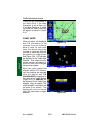
Rev 2 Apr/2004 KMD 250 Pilot’s Guide
3-11
Section 3
Traffic Avoidance
4. The other aircraft is within the “Cone of Silence”. So, remember,
there may be aircraft within your alert area, but if they are not seen by
the radar site they will not show on your display.
5. Your aircraft is below radar coverage. With no obstructions and flat
terrain, the coverage floor is about 2,000-3,000 feet at 60 miles and
4,000-6,000 feet at 100 miles. Terrain and obstacles can substantially
decrease coverage range or make coverage asymmetrical about the
radar site. See Figure 3-13.
6. The other traffic is below radar coverage. The other aircraft may be
in situations mentioned in number 5 and therefore not seen by radar.
Again, there may be aircraft within your alert area, but if they are not
seen by the radar site they will not show on your display.
7. The other aircraft is without an operating a Mode A, C or S
transponder.
8. Bearing error increases as the distance from the radar site
increases. However, distance and relative altitude will remain accurate.
9. Due to the way the radar sites check for transponder faults, a reply
can be interpreted as two different aircraft. This causes a “self alert”.
This is shown as a “pop-up” alert intruder at or near the client’s position
and altitude lasting for only one or two radar scans. It most often occurs
during maneuvering or upon entry into TIS coverage.
NOTE: It is important to understand that no display or aural warning of
traffic information shows the location of all traffic in the vicinity.
Whenever in VMC conditions, continue to visually scan for traffic.
NOTE: Pilots should report TIS outages to Flight Service which will
report them to the Airway Facilities Operations Control Centers for reso-
lution, similar to a report of any other system outage.
Traffic Information Service
Mode-S Terminal Secondary Surveillance Radar
Radar Coverage
Dead Zones
“Cone of Silence”
Figure 3-13 - Obstructions To TIS Coverage


















